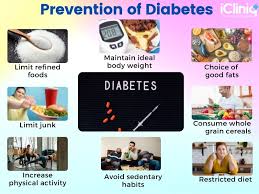Type 2 diabetes mellitus is a chronic condition that affects how your body processes blood sugar (glucose). Unlike type 1 diabetes, where the body doesn’t produce insulin, type 2 diabetes occurs when the body either becomes resistant to insulin or fails to produce enough of it. This results in elevated blood sugar levels, which can lead to serious complications such as heart disease, kidney damage, and nerve problems.
While type 2 diabetes is a significant health issue, the good news is that it is largely preventable. By adopting certain lifestyle changes and making informed health decisions, you can significantly reduce your risk of developing type 2 diabetes. This article delves into effective prevention strategies, ranging from dietary adjustments to physical activity and medical interventions.

Understanding the Risk Factors of Type 2 Diabetes
Genetic Predisposition
One of the most significant risk factors for developing type 2 diabetes is family history. If you have parents or siblings with diabetes, you may be at an increased risk. While you can’t change your genetic makeup, understanding this risk can help you take proactive measures.
Age and Gender
As individuals age, their risk of developing type 2 diabetes increases, particularly after the age of 45. Additionally, men are generally at a higher risk compared to women, although postmenopausal women also face an increased risk due to hormonal changes.
Obesity and Overweight
Being overweight or obese is the most significant modifiable risk factor for type 2 diabetes. Excess weight, especially around the abdomen, contributes to insulin resistance, making it harder for your body to regulate blood sugar levels.
Physical Inactivity
Sedentary lifestyles are another major risk factor. Physical inactivity reduces your body’s ability to process glucose effectively, leading to higher blood sugar levels over time.
Poor Diet
A diet high in processed foods, unhealthy fats, and refined sugars can significantly increase the risk of developing type 2 diabetes. Diets low in fiber and high in calories contribute to weight gain and insulin resistance, setting the stage for diabetes.
Ethnicity
Certain ethnic groups are more prone to developing type 2 diabetes, including African Americans, Hispanic Americans, Native Americans, and Asian Americans. This is largely due to genetic factors that affect how these populations process glucose and insulin.
Effective Prevention Strategies for Type 2 Diabetes
1. Maintaining a Healthy Weight
Achieving and maintaining a healthy weight is the most important step in preventing type 2 diabetes. Even a modest weight loss of 5-10% of your body weight can significantly reduce the risk of diabetes. Losing weight improves insulin sensitivity and helps regulate blood sugar levels.
Tips for Achieving and Maintaining a Healthy Weight:
- Balanced Diet: Focus on whole, nutrient-dense foods, such as vegetables, fruits, lean proteins, whole grains, and healthy fats.
- Caloric Intake Control: Limit the intake of processed foods, sugary snacks, and high-calorie beverages. Aim for smaller, balanced meals throughout the day.
- Regular Monitoring: Use tools like food diaries or apps to track your caloric intake and make adjustments as needed.
2. Regular Physical Activity
Exercise plays a critical role in preventing type 2 diabetes by helping regulate blood sugar levels, enhancing insulin sensitivity, and promoting weight loss. Physical activity, especially aerobic exercises and strength training, can reduce the risk of developing diabetes by up to 50%.
Recommended Exercise Routine:
- Aerobic Exercise: Engage in activities like brisk walking, cycling, or swimming for at least 150 minutes per week.
- Strength Training: Include muscle-strengthening exercises at least two days a week to increase muscle mass and improve glucose metabolism.
- Consistency: Make physical activity a part of your daily routine. Regular movement is key to maintaining long-term health.
3. Following a Diabetes-Friendly Diet
What you eat plays a significant role in preventing type 2 diabetes. A balanced diet not only helps in weight management but also improves your body’s ability to process sugar.
Key Dietary Guidelines for Diabetes Prevention:
- High-Fiber Foods: Include plenty of vegetables, whole grains, legumes, and fruits in your diet. These foods are high in fiber, which helps slow down the absorption of sugar and keeps blood glucose levels steady.
- Healthy Fats: Incorporate healthy fats from sources like avocados, nuts, seeds, and olive oil. These fats are beneficial for heart health and help control blood sugar levels.
- Low Glycemic Index Foods: Choose foods with a low glycemic index (GI) to prevent rapid spikes in blood sugar. Examples include whole grains, non-starchy vegetables, and legumes.
- Limit Refined Carbs and Sugars: Cut back on processed foods, sugary drinks, and foods made with refined flour, as they can quickly raise blood sugar levels.
4. Regular Monitoring of Blood Sugar Levels
For individuals at high risk of developing type 2 diabetes, regular blood sugar monitoring can help detect early signs of insulin resistance or prediabetes. Early intervention can prevent the progression to full-blown diabetes.
Monitoring Strategies:
- Fasting Blood Glucose: This test measures your blood sugar levels after fasting for at least 8 hours. A fasting blood glucose level of 100-125 mg/dL indicates prediabetes, while levels above 126 mg/dL suggest diabetes.
- Hemoglobin A1c: This test provides a three-month average of blood sugar levels. An A1c level of 5.7% to 6.4% suggests prediabetes, and 6.5% or higher indicates diabetes.
- Continuous Glucose Monitoring: For those at high risk, continuous glucose monitoring (CGM) systems can provide real-time insights into fluctuations in blood sugar levels.
5. Managing Stress and Mental Health
Chronic stress can negatively impact blood sugar control and increase the risk of type 2 diabetes by promoting unhealthy eating habits, weight gain, and insulin resistance. Effective stress management can play a pivotal role in diabetes prevention.
Strategies for Managing Stress:
- Mindfulness and Meditation: Regular practice of mindfulness, yoga, or meditation can help reduce stress levels and improve overall well-being.
- Adequate Sleep: Aim for 7-9 hours of sleep per night. Poor sleep patterns can lead to weight gain and insulin resistance.
- Social Support: Engage in social activities and build a support network to manage emotional health and reduce stress.
6. Consideration of Medications for High-Risk Individuals
For those at high risk of type 2 diabetes, healthcare providers may recommend medications in addition to lifestyle changes. These medications can help lower blood sugar levels and improve insulin sensitivity.
Common Medications:
- Metformin: Often prescribed to individuals with prediabetes, metformin helps reduce insulin resistance and lower blood sugar levels.
- GLP-1 Receptor Agonists: These medications help regulate blood sugar by stimulating insulin release and slowing gastric emptying.
Preventing type 2 diabetes is achievable through a combination of lifestyle changes, diet, regular physical activity, and proactive medical care. By understanding the risk factors and adopting strategies such as weight management, a balanced diet, regular exercise, and stress management, individuals can significantly reduce their chances of developing this chronic disease. Early detection and intervention also play a critical role, allowing for effective management and improved long-term health outcomes.
By incorporating these preventive measures, individuals can protect their health, improve their quality of life, and avoid the complications associated with type 2 diabetes.

